Ryobi SG-1155 Manual
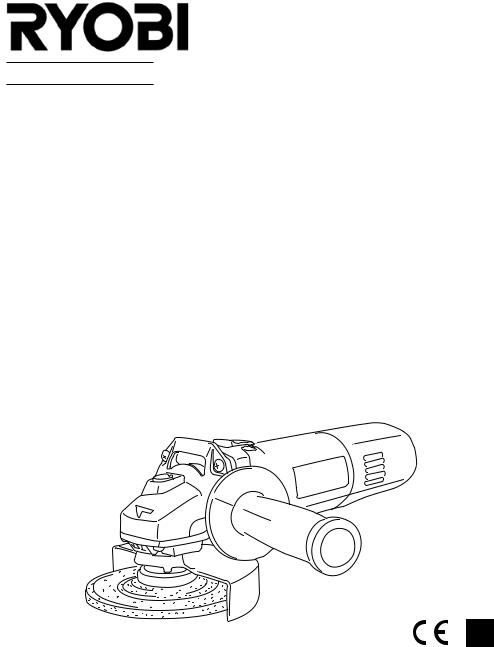
®
SG-1155 / SG-1255
|
F |
|
|
|
|
|
|
MEULEUSE D’ANGLE |
MANUEL D’UTILISATION |
1 |
|
|
GB |
|
ANGLE GRINDER |
USER’S MANUAL |
4 |
|
D |
|
WINKELSCHLEIFER |
BEDIENUNGSANLEITUNG |
7 |
|
E |
|
AMOLADORA EN ÁNGULO |
MANUAL DE UTILIZACIÓN |
10 |
|
I |
|
MOLATRICE ANGOLARE |
MANUALE PER L’UTENTE |
13 |
|
P |
|
REBARBADORA ANGULAR |
MANUAL DE UTILIZAÇÃO |
16 |
|
NL |
|
HAAKSE SLIJPER |
GEBRUIKERSHANDLEIDING |
19 |
|
S |
|
VINKELSLIP |
INSTRUKTIONSBOK |
22 |
|
DK |
|
VINKELSLIBER |
BRUGERVEJLEDNING |
25 |
|
N |
|
VINKELSLIPER |
BRUKSANVISNING |
28 |
|
FIN |
|
KULMAHIOMAKONE |
KÄYTTÄJÄN KÄSIKIRJA |
31 |
|
GR |
|
ΓΩΝΙΑΚ Σ ΤΡ Σ |
∆ΗΓΙΕΣ ΡΗΣΗΣ |
34 |
|
H |
|
SAROKCSISZOLÓ |
HASZNÁLATI ÚTMUTATÓ |
37 |
|
CZ |
|
ÚHLOVÁ BRUSKA |
NÁVOD K OBSLUZE |
40 |
|
RU |
|
мЙгйЗДь тгаойЗДгъзДь еДтазД |
кмдйЗйСлнЗй ий щдлигмДнДсаа |
43 |
|
RO |
|
POLIZOR UNGHIULAR |
MANUAL DE UTILIZARE |
46 |
|
PL |
|
SZLIFIERKA KÑTOWA |
PODR¢CZNIK OBS¸UGI |
49 |
|
|
|
|
|
|
|
|
|
|
|
|
|
|
|
|
|
|

5
4
3
1
2
A
B

Attention !
Important!
Achtung!
¡Atención!
Attenzione!
Atenção!
Let op !
Observera!
OBS!
Advarsel!
Huomio!
Πρ σ ή !
Figyelem !
DÛleÏité upozornûní!
ÇÌËχÌËe!
Aten—ie !
Uwaga !
Il est indispensable que vous lisiez les instructions contenues dans ce manuel avant le montage et la mise en service de l’appareil.
It is essential that you read the instructions in this manual before mounting and operating this machine.
Bitte lesen Sie unbedingt vor Montage und Inbetriebnahme die Hinweise dieser Bedienungsanleitung.
Es imprescindible que lea las instrucciones de este manual antes del montaje y de la puesta en servicio.
Prima di procedere al montaggio e alla messa in funzione, è indispensabile leggere attentamente le istruzioni del presente manuale.
É indispensável ler as instruções deste manual antes de montar e pôr em serviço.
Het is absoluut noodzakelijk vóór montage en inbedrijfstelling de aanwijzingen in deze handleiding te lezen.
Det är nödvändigt att läsa instruktionerna i denna bruksanvisning före montering och driftsättning.
Denne brugsanvisning skal læses igennem inden montering og ibrugtagning.
Vennligst les instruksjonene i denne bruksanvisningen før du monterer og tar i bruk maskinen.
On ehdottoman välttämätöntä lukea tässä käyttöohjeessa annetut ohjeet ennen asennusta ja käyttöönottoa.
Είναι απαραίτητ να δια άσετε τις συστάσεις των δηγιών αυτών πριν τη συναρµ λ γηση και τη θέση σε λειτ υργία.
Feltétlenül fontos, hogy a jelen használati útmutatóban foglalt elŒírásokat az összeszerelés és az üzembe helyezés ellŒt elolvassa !
Pfied montáÏí náfiadí a uvedením do provozu je nutné si pfieãíst následující pokyny.
иe e‰ Т·У НУИ Л Б‡ФЫТНУП ЛМТЪ ЫПeМЪ‡ МeУ·ıУ‰ЛПУ Ф У˜eТЪ¸ ЛМТЪ ЫНˆЛЛ ЛБ М‡ТЪУfl˘e„УЫНУ‚У‰ТЪ‚‡.
Este indispensabil sã citi—i instruc—iunile con—inute în acest mod de utilizare înainte de montaj …i de punerea în func—iune.
Przed montowaniem i uruchomieniem, koniecznie musicie si´ Paƒstwo zapoznaç z zaleceniami zawartymi w niniejszym sposobie u˝ycia.

F |
|
|
|
|
|
|
|
|
|
|
|
|
|
|
|
GB |
D |
E |
P |
NL |
S |
DK |
N |
FIN |
GR |
H |
CZ |
RUS |
RO |
PL |
|
|
|
|
|
|
|
|
|
|
|
|
|
|
|
|
|
Français
D'AVOIR ACHETÉ UN PRODUIT RYOBI
votre outil de façon optimale et en toute veuillez lire attentivement le présent MANUEL D'UTILISATION ainsi que les CONSIGNES DE SÉCURITÉ
.
DESCRIPTION
à ébarber
de protection de la meule auxiliaire
de blocage de l'arbre
de serrage d'entraînement service
diamant (en option)
DE SÉCURITÉ
-vous que la tension utilisée correspond aux figurant sur la plaque signalétique de l'outil. jamais votre outil s'il manque le carter ou
. Si le carter ou des boulons ont été remettez-les en place avant utilisation. Veillez toutes les pièces en bon état de
.
vous travaillez en hauteur, veillez à ce que soient solidement maintenus.
jamais la lame, le foret, la meule ou les mobiles durant l'utilisation.
jamais démarrer votre outil lorsque son rotatif touche la pièce à usiner.
jamais votre outil avant que les éléments ne soient complètement arrêtés.
: l'utilisation d'accessoires et autres que ceux recommandés dans
manuel peut présenter un danger.
DE RECHANGE : seules des pièces de d'origine doivent être utilisées en cas de
.
CONSIGNES DE SÉCURITÉ SPÉCIFIQUES
AUX MEULEUSES D'ANGLE
■Vérifiez que la vitesse indiquée sur la meule à ébarber est égale ou supérieure à la vitesse nominale de l'outil■. Assurez-vous que le diamètre de la meule à ébarber est compatible avec l'outil et que la meule s'insère correctement sur l'arbre.
■Les meules à ébarber doivent être rangées dans un endroit sec.
Ne placez aucun objet sur les meules. Les meules ne doivent pas être utilisées à d'autres fins que des opérations de meulage. Les meules doivent être rangées et manipulées avec précaution, conformément aux instructions du fabricant.
■Avant d'utiliser la meule à ébarber, assurez-vous qu'elle n'est pas ébréchée ou fissurée. Si tel est le cas, la meule peut se briser, ce qui peut entraîner des blessures corporelles graves.
Lorsque vous utilisez une meule neuve, assurez-vous qu'elle est en bon état avant de la monter sur l'outil :
A.vérifiez l'état de la meule à l'aide d'un marteau en bois :
B.tapez doucement tout autour de la meule, en écoutant avec attention les sons émis.
C.les zones ébréchées ou fissurées produiront des sons différents. N'utilisez pas de meules endommagées.
Après avoir monté une meule neuve, faites-la tourner à vide pendant environ 5 minutes en l'orientant de telle sorte qu'elle ne présente aucun danger, c'est-à-dire en la tenant éloignée de toute personne ou de tout objet.
■Assurez-vous que la meule est installée conformément aux instructions du présent manuel.
■Avant d'utiliser votre meuleuse, assurez-vous que la meule est correctement montée et serrée, puis faites tourner votre outil à vide pendant 30 secondes en l'orientant de telle sorte qu'il ne présente aucun danger. Arrêtez immédiatement votre outil s'il vibre excessivement ou si vous remarquez d'autres anomalies. Dans ce cas, contrôlez votre outil pour déterminer la cause du problème.
■N'utilisez pas de bagues de réduction ou d'entretoises pour réduire l'alésage de meules à grand alésage.
■Vérifiez que la pièce à usiner est correctement maintenue.
■N'utilisez que les meules à ébarber recommandées par RYOBI.
1

F |
|
|
|
|
|
|
|
|
|
|
|
|
|
|
|
GB |
D |
E |
P |
NL |
S |
DK |
N |
FIN |
GR |
H |
CZ |
RUS |
RO |
PL |
|
|
|
|
|
|
|
|
|
|
|
|
|
|
|
|
|
Français
DE SÉCURITÉ SPÉCIFIQUES
D'ANGLE
vous utilisez votre meuleuse, assurez-vous que produites ne présentent aucun danger ; garde, par exemple, à ce qu'elles ne soient pas
sur des personnes ou qu'elles n'entrent pas en avec des substances inflammables.
à toujours porter des lunettes de protection et auditives. Si nécessaire, utilisez d'autres
individuelles, tels que des gants, tabliers
.
jamais votre outil sur le sol ou d'autres lorsqu'il est en marche. La meule tourne par après l'arrêt de l'outil. Vous ne devez jamais la meule ou la poser sur le sol ou d'autres
lorsqu'elle tourne.
et l'écrou de serrage doivent avoir le diamètre extérieur.
votre outil que pour les applications décrites le présent manuel d'utilisation. N'utilisez jamais
de refroidissement ou d'eau. N'utilisez pas meuleuse comme un outil fixe.
vous utilisez la meuleuse, tenez-la fermement les deux mains.
|
SG-1155 |
SG-1255 |
Diamètre de la meule |
115 mm |
125 mm |
Fréquence |
50/60 Hz |
50/60 Hz |
|
230 V |
230 V |
Puissance absorbée |
710 W |
750 W |
l'arbre |
M14 |
M14 |
vide |
11 000 tr/min |
11 000 tr/min |
Longueur totale |
274 mm |
274 mm |
|
1,6 kg |
1,6 kg |
les informations figurant sur la plaque du produit, car la tension peut être
en fonction du pays où le produit est utilisé.
maximale de la meule : 4 800 m/min
(Exemple de calcul)
x 125 x 11 000 / 1 000 périphérique de la meule
de la meule
à vide de la meuleuse
ACCESSOIRES STANDARD
Poignée auxiliaire, clé de service.
Pour certains pays, une meule à ébarber est comprise dans les accessoires standard.
APPLICATIONS
(N'utilisez votre outil que pour les applications listées ci-après.)
■Meulage
■Coupe – seulement avec le disque diamant (en option)
EXPOSITION AU BRUIT
Le bruit (ou niveau de pression acoustique) sur le lieu de travail peut dépasser 85 dB (A). Dans ce cas, l'utilisateur doit prendre des mesures d'isolation acoustique et porter des protections auditives.
INTERRUPTEUR (FIG. 1)
Pour mettre en marche ou arrêter la meuleuse, poussez l'interrupteur (5) vers l'avant ou vers l'arrière.
Si vous souhaitez verrouiller la meuleuse pour un fonctionnement en continu, poussez l'interrupteur vers l'avant, puis appuyez sur la partie avant pour bloquer l'interrupteur (A). Pour déverrouiller, appuyez sur la partie arrière de l'interrupteur (B).
INSTALLATION DE LA MEULE (FIG. 2a, 2c)
■Montez le flasque (6), la meule à ébarber (1) et l'écrou de serrage (7) sur l'arbre (8). Vérifiez que le flasque est correctement inséré sur l'arbre.
■Relâchez le bouton de blocage de l'arbre (4) situé sur le côté droit du carter d'engrenages.
■À l'aide de la clé de service (9) fournie, serrez l'écrou de serrage vers la droite.
INSTALLATION DU DISQUE DIAMANT OU
AUTRES DISQUES PLATS (FIG. 2b, 2c)
■Montez le flasque (6), le disque diamant (10) et l'écrou de serrage (7) sur l'arbre (8). Vérifiez que le flasque du disque diamant est correctement inséré sur l'arbre.
■Relâchez le bouton de blocage de l'arbre (4) situé sur le côté droit du carter d'engrenages.
2
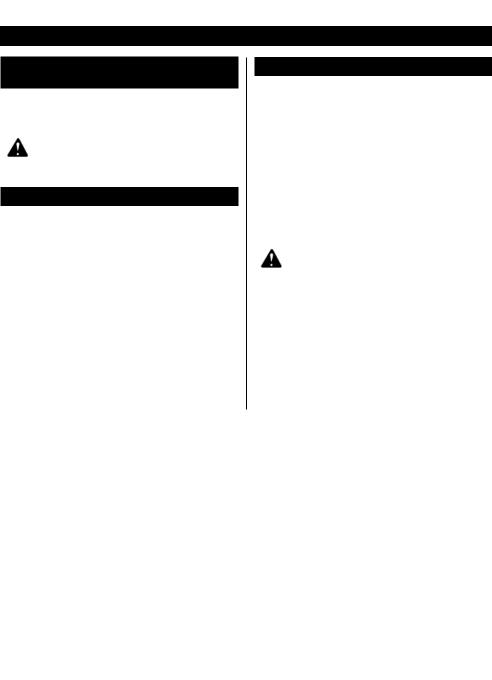
F |
|
|
|
|
|
|
|
|
|
|
|
|
|
|
|
GB |
D |
E |
P |
NL |
S |
DK |
N |
FIN |
GR |
H |
CZ |
RUS |
RO |
PL |
|
|
|
|
|
|
|
|
|
|
|
|
|
|
|
|
|
Français
DU DISQUE DIAMANT OU
DISQUES PLATS (FIG. 2b, 2c)
de la clé de service (9) fournie, serrez l'écrou vers la droite.
!
attentivement que la meule ne présente de fissures. Remplacez immédiatement meule fissurée.
(FIG. 3)
DE PROTECTION DOIVENT ÊTRE EN
VEILLEZ À NE PAS OBSTRUER LES FENTES DE VENTILATION POUR PERMETTRE UN REFROIDISSEMENT CORRECT DU MOTEUR.
travail efficace, il est important de contrôler la pression exercée sur la meuleuse et la surface de la meule et la pièce à usiner. Pour meuler planes, la meuleuse doit former un angle entre 10° et 20°, avec la pièce à usiner.
à la meule le temps d'atteindre sa vitesse maximale avant de commencer le meulage. Avec un meulage trop grand, vous exercez trop de sur une petite surface, ce qui peut creuser ou
de travail.
ENTRETIEN
Après utilisation, assurez-vous que votre outil est en bon état de marche.
Il est recommandé d'apporter votre outil au moins une fois par an dans un Centre Service Agréé Ryobi pour une lubrification et un nettoyage complets.
N'EFFECTUEZ AUCUN RÉGLAGE LORSQUE LE MOTEUR EST EN MARCHE.
VEILLEZ À TOUJOURS DÉBRANCHER LE CORDON D'ALIMENTATION AVANT DE CHANGER LES ACCESSOIRES OU LES PIÈCES D'USURE (LAME, EMBOUT, PAPIER DE VERRE, ETC.), DE LUBRIFIER OU DE MANIPULER L'OUTIL.
ATTENTION !
Pour plus de sécurité et de fiabilité, toutes les réparations doivent être effectuées par un Centre Service Agréé Ryobi.
CONSERVEZ CES INSTRUCTIONS POUR POUVOIR VOUS Y REPORTER ULTÉRIEUREMENT.
3

|
|
|
|
|
|
|
|
|
|
|
|
|
|
|
|
F |
|
D |
E |
P |
NL |
S |
DK |
N |
FIN |
GR |
H |
CZ |
RUS |
RO |
PL |
|
|
|
|
|
|
|
|
|
|
|
|
|
|
|
|
English
THANK YOU FOR BUYING A RYOBI PRODUCT
To ensure your safety and satisfaction, carefully read through this OWNER’S MANUAL and the SAFETY INSTRUCTIONS before using the product.
DESCRIPTION |
|
|
|
1. |
Grinding wheel |
6. |
Disc flange |
2. |
Wheel guard |
7. |
Clamp nut |
3. Aux. handle |
8. |
Spindle shaft |
|
4. |
Lock button |
9. |
Wrench |
5. |
Switch |
10. Diamond blade (optional) |
|
INSTRUCTIONS FOR SAFE HANDLING
■Make sure that the tool is only connected to the voltage marked on the name plate.
■Never use the tool if its cover or any bolts are missing. If the cover or bolts have been removed, replace them prior to use. Maintain all parts in good working order.
■Always secure tools when working in elevated positions.
■Never touch the blade, drill bit, grinding wheel or other moving parts during use.
■Never start a tool when its rotating component is in contact with the work piece.
■Never lay a tool down before its moving parts have come to a complete stop.
■ACCESSORIES: The use of accessories or attachments other than those recommended in this manual might present a hazard.
■REPLACEMENT PARTS: When servicing use only identical replacement parts.
ANGLE GRINDER SAFETY PRECAUTIONS
■Check that the speed marked on the grinding wheel is equal to or greater than the rated speed of the tool.
■Ensure that the dimensions of the grinding wheel are compatible with the tool and that the wheel fits the spindle.
■Grinding wheels must be stored in a dry place.
Do not put any object on the wheels. Grinding wheels must not be used for any operation other than grinding. Grinding wheels must be stored and handled with care in accordance with the manufacturer’s instruction.
■Inspect the grinding wheel before use to ensure that it is not chipped or cracked. Chips or cracks can cause the wheels to shatter, resulting in possible serious injury.
When using new grinding wheels, a sound inspection must be carried out before they are mounted on the tool:
A.Use a wooden hammer for the inspection.
B.Using the hammer, lightly tap all around the wheels, carefully listening to the resulting sounds.
C.Any places with chips or cracks will result in a different sort of sound. Do not use chipped or cracked wheels.
When mounting new grinding wheels, a no-load rotation test must be carried out for approximately 5 minutes with the grinding wheel facing in a safe direction, i.e. away from people or objects.
■Ensure that the wheel is fitted in accordance with this manual.
■Ensure that the grinding wheel is correctly mounted and tightened before use and run the tool at no-load speed for 30 seconds in a safe position. Stop immediately if there is considerable vibration or if other defects are detected. If this condition occurs, check the tool to determine the cause.
■Do not use separate reducing bushings or adapters to adapt large hole grinding wheels.
■Check that the work piece is properly supported.
■Use only grinding wheels approved by RYOBI.
■Ensure that sparks resulting from use do not create a hazard e.g. do not hit people, or ignite flammable substances.
■Always use protective safety glasses and ear protectors. Use other personal protective equipment such as gloves, apron and helmet when necessary.
■Never place the tool on the floor or other surfaces while it is running. Grinding wheels continue to rotate after the tool is switched off. Never touch the wheel or place it on the floor or other surfaces while it is rotating.
■The flange and clamp nut must have the same outer diameter.
■Use the tool only for approved applications. Never use coolants or water or use the tool as a fixed tool.
■Grip the tool securely with both hands while operating.
4
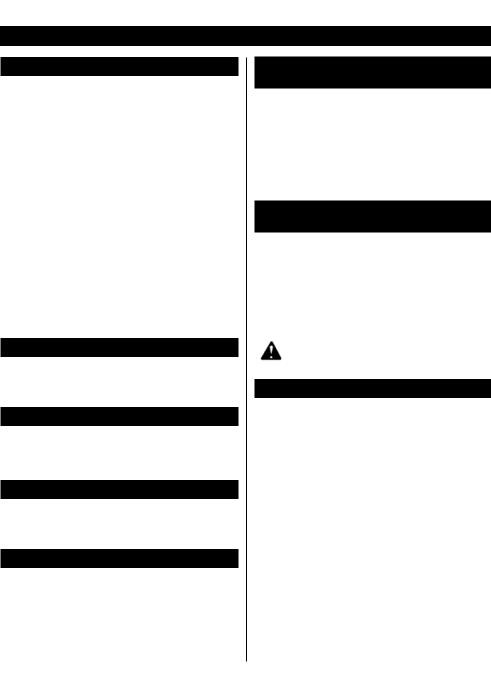
|
|
|
|
|
|
|
|
|
|
|
|
|
|
|
|
F |
|
D |
E |
P |
NL |
S |
DK |
N |
FIN |
GR |
H |
CZ |
RUS |
RO |
PL |
|
|
|
|
|
|
|
|
|
|
|
|
|
|
|
|
English
SPECIFICATIONS
|
SG-1155 |
SG-1255 |
Grinding wheel |
115 mm (4-1/2”) |
125 mm (5") |
Frequency |
50/60 Hz |
50/60 Hz |
Voltage* |
230 V |
230 V |
Input |
710 W |
750 W |
Spindle thread |
M14 |
M14 |
No load speed |
11,000 min.-1 |
11,000 min.-1 |
Overall length |
274 mm (10-3/4”) |
274 mm (10-3/4”) |
Net weight |
1.6 kg (3.5 lbs.) |
1.6 kg (3.5 lbs.) |
*Be sure to check the nameplate on the product, because the voltage is subject to change depending on the area in which the product is to be used.
Maximum circumferential speed of grinding wheel: 4,800 m/min.
(Example of calculation)
4,320 = 3.14 x 125 x 11,000 / 1,000
4,320: Circumferential speed of grinding wheel
125:Wheel diameter
11,000: No load speed of grinder
STANDARD ACCESSORIES
Aux. handle, Wrench.
A grinding wheel is included in the standard accessories for some countries.
APPLICATIONS
(Use only for the purposes listed below.)
■Grinding
■Cutting - for Diamond blade only (optional)
NOISE BUILD-UP
Noise (sound pressure level) in the workplace can exceed 85 dB (A). In this case, sound insulation and hearing protection measures must be taken by the operator.
SWITCH (FIG. 1)
This tool is started and stopped by sliding and releasing the switch (5).
For the convenience for continuous operation, slide the switch along then press the front end down to lock it (action A).
To release the lock, press the rear end of the switch (action B).
MOUNTING THE GRINDING WHEEL
(FIG. 2a, 2c)
■Attach the disc flange (6), the grinding wheel (1) and the outter flange (7) to the spindle shaft (8). Be sure the disc flange is properly seated on the spindle shaft.
■Depress the lock button (4) located on the right side of gear case.
■Using the wrench (9) provided, tighten the clamp nut in a clockwise direction.
MOUNTING THE DIAMOND BLADE AND
OTHER FLAT WHEELS (FIG. 2b, 2c)
■Attach the disc flange (6), the blade (10) and the outter flange (7) to the spindle shaft (8). Be sure that the blade flange is properly seated on the spindle shaft.
■Depress the lock button (4) located on the right side of gear case.
■Using the wrench (9) provided, tighten the clamp nut in a clockwise direction.
WARNING!
Check carefully whether or not there are cracks in the wheel. Replace a cracked wheel immediately.
OPERATING (FIG. 3)
KEEP SAFETY GUARDS IN PLACE.
NEVER COVER THE AIR VENTS SINCE THEY MUST ALWAYS BE OPEN FOR PROPER MOTOR COOLING.
The key to efficient operating is controlling the pressure and surface contact between the disc and work piece. Flat surfaces are ground at an acute angle, usually 10 to 20 degrees with the work piece. Allow the disc to reach full speed before starting to grind. Too great angle causes concentration of pressure on a small area which may gouge or burn work surface.
5
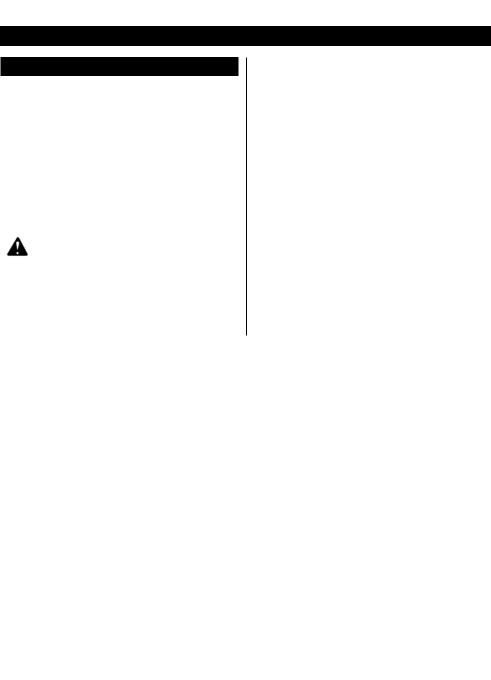
|
|
|
|
|
|
|
|
|
|
|
|
|
|
|
|
F |
|
D |
E |
P |
NL |
S |
DK |
N |
FIN |
GR |
H |
CZ |
RUS |
RO |
PL |
|
|
|
|
|
|
|
|
|
|
|
|
|
|
|
|
English
MAINTENANCE
After use, check the tool to make sure that it is in top condition.
It is recommended that you take this tool to a Ryobi Authorized Service Center for a thorough cleaning and lubrication at least once a year.
DO NOT MAKE ANY ADJUSTMENTS WHILE THE MOTOR IS IN MOTION.
ALWAYS DISCONNECT THE POWER CORD FROM THE RECEPTACLE BEFORE CHANGING REMOVABLE OR EXPENDABLE PARTS (BLADE, BIT, SANDING PAPER ETC.), LUBRICATING OR WORKING ON THE UNIT.
WARNING!
To ensure safety and reliability, all repairs should be performed by an authorized service or other qualified service organization.
SAVE THESE INSTRUCTIONS FOR FUTURE REFERENCE.
6

|
|
|
|
|
|
|
|
|
|
|
|
|
|
|
|
F |
GB |
|
E |
P |
NL |
S |
DK |
N |
FIN |
GR |
H |
CZ |
RUS |
RO |
PL |
|
|
|
|
|
|
|
|
|
|
|
|
|
|
|
|
Deutsch
VIELEN DANK, DASS SIE SICH FÜR EIN
PRODUKT VON RYOBI ENTSCHIEDEN HABEN
Lesen Sie vor der Verwendung Ihres Geräts die vorliegende BEDIENUNGSANLEITUNG sowie die SICHERHEITSVORSCHRIFTEN gründlich durch, um eine optimale und sichere Verwendung zu gewährleisten.
BESCHREIBUNG
1.Schleifscheibe
2.Schleifscheiben-Schutzkappe
3.Zusatzgriff
4.Knopf zur Blockierung der Welle
5.Ein-/Aus-Schalter
6.Flansch
7.Spannmutter
8.Antriebswelle
9.Bedienungsschlüssel
10.Diamantscheibe (optional)
SICHERHEITSVORSCHRIFTEN
■Vergewissern Sie sich, dass das Gerät an ein Netz mit der auf dem Typenschild angegebenen Spannung angeschlossen wird.
■Verwenden Sie Ihr Gerät niemals, wenn das Schutzgehäuse oder Schrauben fehlen. Wenn das Schutzgehäuse oder Schrauben entfernt wurden, müssen diese vor der Verwendung wieder eingesetzt werden. Achten Sie darauf, dass alle Teile stets in einwandfreiem Zustand sind.
■Achten Sie beim Arbeiten in der Höhe darauf, dass Ihre Geräte gut befestigt sind.
■Berühren Sie während der Verwendung niemals das Sägeblatt, den Bohrer, die Schleifscheibe oder die anderen beweglichen Elemente.
■Schalten Sie Ihr Gerät niemals ein, wenn sein rotierendes Element das Werkstück berührt.
■Legen Sie Ihr Gerät niemals ab, bevor die beweglichen Elemente nicht vollständig zum Stillstand gekommen sind.
■ZUBEHÖR: Die Benutzung von anderen als den in der vorliegenden Bedienungsanleitung empfohlenen Zubehörteilen und Zusatzgeräten kann gefährlich sein.
■ERSATZTEILE: Bei einem Austausch von Teilen dürfen nur Originalersatzteile von Ryobi verwendet werden.
SPEZIFISCHE SICHERHEITSVORSCHRIFTEN
FÜR WINKELSCHLEIFER
■Prüfen Sie, ob die auf der Schleifscheibe angegebene Höchstdrehzahl mindestens der Nenndrehzahl des Geräts entspricht.
■Vergewissern Sie sich, dass der Durchmesser der Schleifscheibe dem Gerät entspricht und dass die Schleifscheibe einwandfrei auf der Welle sitzt.
■Die Schleifscheiben müssen an einem trockenen Ort aufbewahrt werden.
Stellen Sie kein Objekt auf die Schleifscheibe. Die Schleifscheiben dürfen ausschließlich zu Schleifoperationen verwendet werden. Die Schleifscheiben müssen aufgeräumt und vorsichtig gehandhabt werden (entsprechend den Angaben des Herstellers).
■Vergewissern Sie sich vor Verwendung der Schleifscheibe, dass diese keine ausgebrochenen Stellen oder Risse aufweist. Falls dies der Fall ist, kann die Scheibe brechen und dies kann zu schweren Körperverletzungen führen.
Vergewissern Sie sich bei Verwendung einer neuen Schleifscheibe, dass diese in einwandfreiem Zustand ist, bevor Sie sie am Gerät montieren:
A.Prüfen Sie den Zustand der Schleifscheibe mit Hilfe eines Holzhammers:
B.Klopfen Sie den gesamten äußeren Bereich der Scheibe mit dem Hammer ab und hören Sie auf den Klang.
C.Die ausgebrochenen Bereiche geben andere Klänge aus. Verwenden Sie keine beschädigten Schleifscheiben.
Nach der Montage einer neuen Schleifscheibe muss diese zuerst ca. 5 Minuten ohne Belastung laufen. Dabei ist das Gerät so zu halten, dass keine gefährliche Situation auftreten kann, d. h. die Scheibe muss von Personen oder Objekten fern gehalten werden.
■Vergewissern Sie sich, dass die Schleifscheibe gemäß den Anweisungen der vorliegenden Bedienungsanleitung montiert ist.
■Vergewissern Sie sich vor der Verwendung Ihres Schleifers, dass die Schleifscheibe korrekt montiert und angezogen ist, und lassen Sie Ihr Gerät dann während 30 Sekunden ohne Belastung laufen; halten Sie das Gerät dabei so, dass keine gefährliche Situation auftritt. Halten Sie Ihr Gerät sofort an, wenn es zu stark vibriert oder wenn Sie andere Anomalien feststellen. Kontrollieren Sie in diesem Fall Ihr Gerät, um die Ursache des Problems festzustellen.
7

|
|
|
|
|
|
|
|
|
|
|
|
|
|
|
|
F |
GB |
|
E |
P |
NL |
S |
DK |
N |
FIN |
GR |
H |
CZ |
RUS |
RO |
PL |
|
|
|
|
|
|
|
|
|
|
|
|
|
|
|
|
Deutsch
SPEZIFISCHE SICHERHEITSVORSCHRIFTEN
FÜR WINKELSCHLEIFER
■Verwenden Sie keine Reduzierringe oder Zwischenstücke, um die Bohrung von Schleifscheiben mit zu großer Bohrung zu verkleinern.
■Prüfen Sie, ob das zu bearbeitende Werkstück korrekt befestigt ist.
■Verwenden Sie nur die von RYOBI empfohlenen Schleifscheiben.
■Vergewissern Sie sich während der Verwendung Ihres Schleifers, dass die entstehenden Funken keine Gefahr darstellen; achten Sie beispielsweise darauf, dass weder mit Personen noch mit entzündlichen Substanzen in Kontakt kommen.
■Tragen Sie stets eine Schutzbrille und einen Gehörschutz. Verwenden Sie falls erforderlich andere individuelle Schutzausrüstungen, wie z. B. Handschuhe, Schürzen oder Helme.
■Stellen Sie Ihr Gerät niemals auf den Boden oder andere Flächen, während es in Betrieb ist. Die Schleifscheibe kommt nach dem Ausschalten erst nach einigen Momenten zu einem vollständigen Stillstand. Während die Schleifscheibe läuft, dürfen Sie sie niemals berühren oder auf den Boden oder andere Flächen stellen.
■Der Flansch und die Spannmutter müssen den selben Außendurchmesser haben.
■Verwenden Sie das Gerät nur für die in dieser Bedienungsanleitung beschriebenen Anwendungen. Verwenden Sie niemals Kühlflüssigkeit oder Kühlwasser. Setzen Sie Ihren Schleifer niemals als ein stationäres Gerät ein.
■Halten Sie Ihren Schleifer bei der Verwendung mit beiden Händen fest.
MERKMALE
|
SG-1155 |
SG-1255 |
Durchmesser der |
|
|
Schleifscheibe |
115 mm |
125 mm |
Frequenz |
50/60 Hz |
50/60 Hz |
Spannung* |
230 V |
230 V |
Leistungsaufnahme |
710 W |
750 W |
Gewinde der Welle |
M14 |
M14 |
Leerlaufdrehzahl |
11.000 U./Min. |
11.000 U./Min. |
Gesamtlänge |
274 mm |
274 mm |
Nettogewicht |
1,6 kg |
1,6 kg |
8
*Prüfen Sie das Typenschild des Geräts, denn die Spannung kann je nach Land, in dem das Gerät verwendet wird, unterschiedlich sein.
Maximale Umfangsgeschwindigkeit der Schleifscheibe: 4 800 m/min.
(Berechnungsbeispiel)
4 320 = 3,14 x 125 x 11 000 / 1 000
4 320: Umfangsgeschwindigkeit der Schleifscheibe
125:Durchmesser der Schleifscheibe
11 000: Leerlaufgeschwindigkeit der Schleifscheibe
STANDARDZUBEHÖR
Zusatzgriff, Bedienungsschlüssel.
In bestimmten Ländern ist eine Schleifscheibe im Standardzubehör enthalten.
ANWENDUNGEN
(Verwenden Sie Ihr Gerät nur für die unten aufgeführten Anwendungen.)
■Schleifen
■Schneiden – nur mit der Diamantscheibe (optional)
LÄRMBELASTUNG
Der Lärm (oder Schalldruckpegel) am Arbeitsplatz kann über 85 dB (A) liegen. In diesem Fall muss der Benutzer geeignete Maßnahmen zur Schallisolierung treffen und einen Gehörschutz tragen.
EIN-/AUS-SCHALTER (ABB. 1)
Zum Einoder Ausschalten des Schleifgeräts drücken Sie den Ein-/Aus-Schalter (5) nach vorne oder nach hinten. Wenn Sie das Schleifgerät auf fortlaufenden Betrieb stellen möchten, drücken Sie den Ein-/Aus-Schalter nach vorne und dann auf den vorderen Teil, um den Schalter zu blockieren (A).
Zum Entsperren drücken Sie auf den hinteren Teil des Ein-/Aus-Schalters (B).
MONTAGE DER SCHLEIFSCHEIBE
(ABB. 2a, 2c)
■Montieren Sie den Flansch (6), die Schleifscheibe (1) und die Spannmutter (7) an der Welle. Prüfen Sie, dass der Flansch einwandfrei auf der Welle sitzt.
■Geben Sie den Blockierknopf der Welle (4), der sich rechts vom Getriebegehäuse befindet, frei.
■Ziehen Sie die Spannmutter mit dem bereitgestellten Bedienungsschlüssel (9) an (nach rechts drehen).

|
|
|
|
|
|
|
|
|
|
|
|
|
|
|
|
F |
GB |
|
E |
P |
NL |
S |
DK |
N |
FIN |
GR |
H |
CZ |
RUS |
RO |
PL |
|
|
|
|
|
|
|
|
|
|
|
|
|
|
|
|
Deutsch
MONTAGE DER DIAMANTSCHEIBE ODER ANDERER FLACHER SCHEIBEN
(ABB. 2B, 2C)
■Montieren Sie den Flansch (6), die Diamantscheibe (10) und die Spannmutter (7) an der Welle (8). Prüfen Sie, ob der Flansch der Diamantscheibe einwandfrei auf der Welle sitzt.
■Geben Sie den Blockierknopf der Welle (4), der sich rechts vom Getriebekasten befindet, frei.
■Ziehen Sie die Spannmutter mit dem bereitgestellten Bedienungsschlüssel (9) an (nach rechts drehen).
ACHTUNG!
Prüfen Sie sorgfältig, ob die Schleifscheibe keine Risse aufweist. Ersetzen Sie alle Schleifscheiben mit Rissen sofort.
VERWENDUNG (ABB. 3)
DIE SCHUTZKAPPEN MÜSSEN MONTIERT SEIN. ACHTEN SIE DARAUF, DASS SIE DIE BELÜFTUNGSSCHLITZE NICHT ABDECKEN, UM EIN KORREKTES ABKÜHLEN DES MOTORS ZU GEWÄHRLEISTEN.
Für eine effiziente Arbeit, muss der auf den Schleifer ausgeübte Druck und die Kontaktfläche zwischen der Schleifscheibe und dem zu bearbeitenden Teil kontrolliert werden. Flache Flächen werden mit einem spitzen Winkel zwischen der Schleifscheibe und dem Werkstück (normalerweise zwischen 10° und 20°) bearbeitet. Warten Sie, bis die Schleifscheibe ihre maximale Geschwindigkeit erreicht hat, bevor Sie mit dem Schleifen beginnen. Bei einem zu großen Winkel wird zu starker Druck auf eine kleine Fläche ausgeübt und dies kann die Arbeitsfläche aushöhlen oder verbrennen.
WARTUNG
Vergewissern Sie sich nach der Verwendung, dass Ihr Gerät in einwandfreiem Zustand ist.
Es empfiehlt sich, Ihr Gerät mindestens einmal pro Jahr zu einem autorisierten Ryobi-Kundendienst zu bringen, um es komplett zu schmieren und zu reinigen.
NEHMEN SIE KEINE EINSTELLUNG VOR, WÄHREND DER MOTOR IN BETRIEB IST.
ACHTEN SIE DARAUF, DAS STROMKABEL STETS ZU ENTFERNEN, BEVOR SIE ZUBEHÖRODER VERSCHLEISSTEILE AUSWECHSELN (SÄGEBLATT, EINSATZSTÜCK, GLASPAPIER USW.) UND BEVOR SIE DAS GERÄT SCHMIEREN ODER HANDHABEN.
ACHTUNG!
Für eine höhere Sicherheit und Zuverlässigkeit müssen alle Reparaturen von einem autorisierten Ryobi-Kundendienst durchgeführt werden.
BEWAHREN SIE DIESE ANWEISUNGEN AUF, UM SIE SPÄTER HERANZIEHEN ZU KÖNNEN.
9

|
|
|
|
|
|
|
|
|
|
|
|
|
|
|
|
F |
GB |
D |
|
P |
NL |
S |
DK |
N |
FIN |
GR |
H |
CZ |
RUS |
RO |
PL |
|
|
|
|
|
|
|
|
|
|
|
|
|
|
|
|
Español
LE AGRADECEMOS POR HABER COMPRADO
UN PRODUCTO RYOBI
Para emplear de forma óptima esta herramienta sin correr ningún riesgo, lea atentamente este MANUAL DE INSTRUCCIONES y las correspondientes CONSIGNAS DE SEGURIDAD antes de utilizarla.
DESCRIPCIÓN
1.Disco para desbarbar
2.Cárter de protección del disco
3.Empuñadura auxiliar
4.Botón de bloqueo del árbol
5.Interruptor
6.Brida
7.Tuerca de apriete
8.Árbol de arrastre
9.Llave de servicio
10.Disco de diamante (opcional)
CONSIGNAS DE SEGURIDAD
■Compruebe que la tensión utilizada corresponde a las indicaciones que figuran en la placa donde se describen las características de la herramienta.
■No utilice la herramienta sin el cárter o si falta algún perno. Si el cárter o los pernos han sido desmontados, móntelos antes de utilizarla. Mantenga las piezas en buen estado de funcionamiento.
■Cuando trabaje en lugares altos, compruebe que las herramientas estén bien sujetas.
■Cuando trabaje con la máquina, no toque nunca el disco ni cualquier otro elemento móvil.
■No ponga en marcha la herramienta cuando su elemento rotativo esté en contacto con la pieza trabajada.
■No deje nunca la herramienta hasta que todos los elementos móviles se hayan detenido completamente.
■ACCESORIOS: La utilización de accesorios y equipos diferentes a los recomendados en este manual puede resultar peligrosa.
■PIEZAS DE RECAMBIO: Si fuera preciso cambiar alguna pieza, sólo se deben utilizar recambios originales.
CONSIGNAS DE SEGURIDAD PARA LA
AMOLADORA EN ÁNGULO
■Verifique que la velocidad indicada en el disco para desbarbar sea igual o superior a la velocidad nominal de la herramienta.
■Compruebe que el diámetro del disco para desbarbar sea compatible con la herramienta y que se inserte correctamente en el árbol.
■Los discos para desbarbar deben guardarse en un lugar seco.
No coloque ningún objeto sobre los discos. Los discos sólo se deben utilizar para las operaciones de pulido o esmerilado. Los discos se guardarán y manipularán con precaución, de conformidad con las instrucciones del fabricante.
■Antes de utilizar el disco para desbarbar, cerciórese de que no esté mellado o fisurado. De ser así, el disco podría quebrarse produciendo graves heridas.
Cuando utilice una muela nueva, cerciórese de que esté en buen estado antes de montarla en la herramienta:
A.Verifique el estado del disco con un martillo de madera:
B.Golpee suavemente con el martillo distintas partes del disco y escuche con atención los sonidos que produce.
C.Las zonas melladas o fisuradas producirán un sonido diferente. No utilice discos deteriorados.
Después de haber montado un nuevo disco, hágalo girar en vacío unos 5 minutos orientándolo de forma que no represente ningún peligro, es decir, lejos de cualquier persona u objeto.
■Cerciórese de que el disco esté ajustado de acuerdo a las instrucciones de este manual.
■Antes de utilizar la amoladora, cerciórese de que el disco esté correctamente montado y bien apretado y, después, haga funcionar la herramienta en vacío durante 30 segundos orientándola de forma que no represente ningún peligro. Pare inmediatamente la herramienta si vibra excesivamente o si observa alguna anomalía. En este caso, contrólela para determinar la causa de dicho problema.
■No utilice anillos de reducción o adaptadores para reducir el diámetro interior de algunos discos.
■Verifique que la pieza trabajada esté bien sujeta.
■Utilice únicamente discos para desbarbar recomendados por RYOBI.
10

|
|
|
|
|
|
|
|
|
|
|
|
|
|
|
|
F |
GB |
D |
|
P |
NL |
S |
DK |
N |
FIN |
GR |
H |
CZ |
RUS |
RO |
PL |
|
|
|
|
|
|
|
|
|
|
|
|
|
|
|
|
Español
CONSIGNAS DE SEGURIDAD PARA LA
AMOLADORA EN ÁNGULO
■Cuando trabaje con su amoladora, cerciórese de que las chispas no presenten peligro alguno. Por ejemplo, cerciórese de que no se dirigen hacia las personas o que no están en contacto con materiales inflamables.
■Utilice gafas de protección y dispositivos de protección auditiva. Si fuera necesario, utilice otros dispositivos de protección como guantes, delantal o casco.
■No coloque nunca la herramienta en el suelo ni en ninguna superficie cuando esté en marcha. El disco sigue girando por inercia después de que se pare la herramienta. No debe tocar nunca el disco, ni ponerlo en el suelo o en alguna superficie cuando aún esté girando.
■La brida del disco y la tuerca de apriete deben tener el mismo diámetro exterior.
■Utilice la máquina únicamente para las tareas descritas en este manual de instrucciones. No utilice nunca fluido de refrigeración o agua. No utilice la amoladora como una herramienta fija.
■Cuando la ponga en marcha, sujétela bien con ambas manos.
CARACTERÍSTICAS
|
SG-1155 |
SG-1255 |
Diámetro del disco |
115 mm |
125 mm |
Frecuencia |
50/60 Hz |
50/60 Hz |
Tensión* |
230 V |
230 V |
Potencia absorbida |
710 W |
750 W |
Roscado del árbol |
M14 |
M14 |
Velocidad en vacío |
11.000 r.p.m. |
11.000 r.p.m. |
Longitud total |
274 mm |
274 mm |
Peso neto |
1,6 kg |
1,6 kg |
*Compruebe los datos que figuran en la placa del producto, ya que la tensión puede variar en función del país en donde se utilice la herramienta.
Velocidad periférica máxima del disco: 4.800 m/min
(Ejemplo de cálculo)
4.320 = 3,14 x 125 x 11.000/1.000 4.320: Velocidad periférica del disco
125:Diámetro del disco
11.000: Velocidad de la amoladora en vacío
ACCESORIOS ESTÁNDARES
Empuñadura auxiliar, llave de servicio.
En algunos países, los accesorios estándares incluyen un disco para desbarbar.
APLICACIONES
(Utilice la herramienta únicamente para las aplicaciones que se indican a continuación.)
■Pulido / esmerilado
■Corte – solamente con el disco de diamante (opcional)
EXPOSICIÓN AL RUIDO
El ruido (o nivel de presión acústica) en el lugar de trabajo puede superar los 85 dB (A). En este caso, el usuario debe instalar un aislamiento acústico y utilizar elementos de protección auditiva.
INTERRUPTOR (FIG. 1)
Para poner en marcha o detener la amoladora, desplace el interruptor (5) hacia adelante o hacia atrás.
Si desea que la amoladora funcione de forma continua, desplace el interruptor hacia adelante y pulse la parte delantera para bloquearlo (A).
Para desbloquearlo, haga presión en la parte trasera (B).
INSTALACIÓN DEL DISCO (FIG. 2a, 2c)
■Monte la brida (6), el disco para desbarbar (1) y la tuerca de apriete (7) en el árbol (8). Verifique que la brida esté correctamente inserta en el árbol.
■Suelte el botón de bloqueo del árbol (4) que se encuentra del lado derecho del cárter de engranajes.
■Apriete hacia la derecha la tuerca de apriete, utilizando para ello la llave de servicio suministrada (9).
INSTALACIÓN DEL DISCO DE DIAMANTE O
DE OTROS DISCOS PLANOS (FIG. 2b, 2c)
■Monte la brida (6), el disco de diamante (10) y la tuerca de apriete (7) en el árbol (8). Verifique que la brida del disco de diamante esté correctamente inserta en el árbol.
■Suelte el botón de bloqueo del árbol (4) que se encuentra del lado derecho del cárter de engranajes.
11

|
|
|
|
|
|
|
|
|
|
|
|
|
|
|
|
F |
GB |
D |
|
P |
NL |
S |
DK |
N |
FIN |
GR |
H |
CZ |
RUS |
RO |
PL |
|
|
|
|
|
|
|
|
|
|
|
|
|
|
|
|
Español
INSTALACIÓN DEL DISCO DE DIAMANTE O
DE OTROS DISCOS PLANOS (FIG. 2b, 2c)
■Apriete hacia la derecha la tuerca de apriete, utilizando para ello la llave de servicio suministrada (9).
¡ATENCIÓN!
Verifique atentamente que el disco no tenga fisuras. Cambie inmediatamente los discos fisurados.
UTILIZACIÓN (FIG. 3)
LOS CÁRTERES DE PROTECCIÓN DEBEN ESTAR COLOCADOS.
NO OBSTRUYA LAS RANURAS DE VENTILACIÓN PARA QUE EL MOTOR SE VENTILE CORRECTAMENTE.
Para un trabajo eficaz, es importante controlar la presión que se ejerce en la herramienta, y la superficie de contacto entre el disco y la pieza trabajada. Para trabajar superficies planas, la amoladora debe formar un ángulo agudo, generalmente de 10° a 20°, con la pieza trabajada. Deje que el disco alcance su velocidad máxima antes de comenzar a trabajar. Un ángulo demasiado amplio provoca un exceso de presión en una superficie pequeña, lo que puede perforar o quemar la superficie de trabajo.
MANTENIMIENTO
Después de utilizar la máquina, cerciórese de que se encuentre en perfecto estado de marcha.
Le recomendamos que lleve la máquina al menos una vez al año a un Centro de Servicio Habilitado Ryobi para una lubricación y una limpieza completas.
NO HAGA NINGÚN AJUSTE CUANDO EL MOTOR ESTÉ EN MARCHA.
DESENCHUFE SIEMPRE EL CABLE DE ALIMENTACIÓN ANTES DE CAMBIAR LOS ACCESORIOS O LAS PIEZAS DE GASTADAS (DISCO, ETC.) Y ANTES DE LUBRICAR O MANIPULAR LA HERRAMIENTA.
¡ATENCIÓN!
Para más seguridad y fiabilidad, todas las reparaciones deben realizarse en un Centro de Servicio Habilitado Ryobi.
CONSERVE ESTAS INSTRUCCIONES PARA CONSULTARLAS ULTERIORMENTE.
12

|
|
|
|
|
|
|
|
|
|
|
|
|
|
|
|
|
F |
GB |
D |
E |
|
P |
NL |
S |
DK |
N |
FIN |
GR |
H |
CZ |
RUS |
RO |
PL |
|
|
|
|
|
|
|
|
|
|
|
|
|
|
|
|
|
Italiano
GRAZIE PER AVER ACQUISTATO UN
PRODOTTO RYOBI
Per lavorare in condizioni di massima sicurezza e per fare in modo che l’apparecchio funzioni perfettamente, leggere attentamente il presente MANUALE PER L’UTENTE e le NORME DI SICUREZZA.
DESCRIZIONE
1.Mola per rifilare
2.Carter di protezione della mola
3.Impugnatura ausiliaria
4.Dispositivo per il bloccaggio dell'albero
5.Interruttore
6.Flangia
7.Dado di serraggio
8.Albero di trasmissione
9.Chiave di servizio
10.Disco diamante (in opzione)
NORME DI SICUREZZA
■Accertarsi che la tensione utilizzata corrisponda alle indicazioni che figurano sulla piastrina d’identificazione dell’apparecchio.
■Non utilizzare mai l'apparecchio se mancano il carter o alcuni bulloni. Prima dell’uso, procedere sempre all'installazione del carter o dei bulloni mancanti. Verificare il perfetto stato di funzionamento di ogni elemento.
■Quando si lavora in posizione sopraelevata, fare attenzione che gli apparecchi siano sempre saldamente bloccati.
■Mentre l’apparecchio è in funzione, non toccare mai la lama, la punta, la mola o altri elementi mobili.
■Non avviare mai l’apparecchio quando l’elemento rotante è a contatto con il pezzo da lavorare.
■Prima di posare l'apparecchio, attendere che tutti gli elementi mobili si siano completamente arrestati.
■ACCESSORI: L'utilizzo di accessori o apparecchiature non raccomandati nel presente manuale può essere pericoloso.
■PEZZI DI RICAMBIO: In caso di sostituzione, utilizzare solo pezzi di ricambio originali.
NORME DI SICUREZZA PER LA MOLATRICE
ANGOLARE
■Verificare che la velocità indicata sulla mola per rifilare sia uguale o superiore alla velocità nominale dell’apparecchio.
■Accertarsi che le dimensioni della mola per rifilare siano compatibili con quelle dell’apparecchio e che la mola si inserisca correttamente sull’albero.
■Riporre le mole per rifilare in un ambiente asciutto. Non collocare alcun oggetto sopra le mole. Non utilizzare le mole per effettuare lavorazioni diverse dalla molatura. Riporre e maneggiare le mole con cura, in modo conforme alle istruzioni.
■Prima di utilizzare la mola per rifilare, accertarsi che non sia sbrecciata o presenti delle fessure. Nel caso sia sbrecciata o presenti delle fessure, la mola può rompersi e provocare gravi ferite al corpo.
Prima di montare una mola nuova sull’apparecchio, accertarsi che sia in buono stato:
A.Verificare lo stato della mola mediante un martello in legno:
B.Battere delicatamente con il martello intorno alla mola, ascoltandone attentamente i suoni prodotti.
C.Le zone sbrecciate o fessurate produrranno suoni diversi. Non utilizzare mole danneggiate.
Dopo aver montato una mola nuova, farla girare a vuoto per circa 5 minuti orientandola in modo tale che non rappresenti un pericolo (tenerla distante da persone e oggetti).
■Accertarsi che la mola sia regolata in modo conforme alle istruzioni fornite nel presente manuale.
■Prima dell’utilizzo, accertarsi altresì che la mola sia montata e bloccata in modo esatto, quindi fare girare l’apparecchio a vuoto per circa 30 secondi orientandolo in modo tale che non rappresenti un pericolo. Arrestare immediatamente l’apparecchio nel caso in cui vibri eccessivamente oppure se si notano altre anomalie. In questo caso, controllare l’apparecchio per determinare la causa del problema.
■Non utilizzare riduttori o adattatori per adattare delle mole di alesaggio superiore.
■Verificare che il pezzo da lavorare sia bloccato in modo corretto.
■Utilizzare solo mole per rifilare raccomandate da RYOBI.
■Quando si utilizza la molatrice, accertarsi che le scintille prodotte non rappresentino un pericolo; fare attenzione, ad esempio, che non vengano proiettate su persone o che non entrino a contatto con sostanze infiammabili.
13

|
|
|
|
|
|
|
|
|
|
|
|
|
|
|
|
|
F |
GB |
D |
E |
|
P |
NL |
S |
DK |
N |
FIN |
GR |
H |
CZ |
RUS |
RO |
PL |
|
|
|
|
|
|
|
|
|
|
|
|
|
|
|
|
|
Italiano
NORME DI SICUREZZA PER LA MOLATRICE
ANGOLARE
■Indossare sempre degli occhiali protettivi e delle protezioni per l’udito. Se necessario, utilizzare altri sistemi di protezione, ad esempio guanti, grembiuli o caschi.
■Non adagiare mai l’apparecchio acceso sul pavimento o su altre superfici mentre è in funzione. Dopo l’arresto dell’apparecchio, la mola continua a girare per inerzia. Non toccare, né posare a terra o su altre superfici, la mola in movimento.
■La flangia e il dado di serraggio devono avere lo stesso diametro esterno.
■Utilizzare l’apparecchio solo per le applicazioni descritte nel presente manuale per l’utente. Non utilizzare mai del liquido di raffreddamento o dell’acqua. Non utilizzare l’apparecchio come un apparecchio fisso.
■Durante l’utilizzo, tenere la molatrice ben salda con entrambe le mani.
CARATTERISTICHE
|
SG-1155 |
SG-1255 |
||
Diametro della mola |
115 mm |
125 mm |
||
Frequenza |
50/60 Hz |
50/60 Hz |
||
Tensione* |
230 |
V |
230 |
V |
Potenza assorbita |
710 |
W |
750 |
W |
Filettatura dell'albero |
M14 |
M14 |
||
Velocità a vuoto |
11.000 giri/min |
11.000 giri/min |
||
Lunghezza totale |
274 mm |
274 mm |
||
Peso netto |
1,6 kg |
1,6 kg |
||
*Verificare le informazioni presenti sulla piastrina d’identificazione del prodotto poiché la tensione potrebbe variare in funzione del luogo in cui il prodotto viene utilizzato.
Velocità periferica massima della mola: 4.800 m/min
(Esempio di calcolo)
4.320 = 3,14 x 125 x 11.000 / 1.000 4.320: Velocità periferica della mola
125:Diametro della mola
11.000: Velocità a vuoto della molatrice
ACCESSORI STANDARD
Impugnatura ausiliaria, chiave di servizio.
In alcuni paesi, la mola per rifilare fa parte degli accessori standard.
APPLICAZIONI
(Utilizzare l’apparecchio solo per le applicazioni qui di seguito elencate.)
■Molatura
■Taglio – solo con disco diamante (in opzione)
ESPOSIZIONE AL RUMORE
Il rumore (o livello di pressione acustica) sul luogo di lavoro può superare gli 85 dB (A). In questo caso, l’utente deve prendere le necessarie precauzioni di isolamento acustico ed indossare delle protezioni per l’udito.
INTERRUTTORE (FIG. 1)
Per avviare o arrestare la molatrice, premere l’interruttore
(5) in avanti o indietro.
Nel caso in cui si desideri bloccare la molatrice per avere un funzionamento in modo continuo, spingere in avanti l’interruttore quindi premere la parte anteriore per bloccare l’interruttore (A).
Per sbloccare, premere la parte posteriore dell’ interruttore (B).
INSTALLAZIONE DELLA MOLA (FIG. 2a, 2c)
■Montare la flangia (6), la mola per rifilare (1) e il dado di serraggio (7) sull’albero (8). Verificare che la flangia sia inserita sull’albero in modo corretto.
■Rilasciare il pulsante di bloccaggio dell’albero (4) posto sul lato destro del carter degli ingranaggi.
■Mediante la chiave di servizio in dotazione (9), serrare il bullone verso destra.
INSTALLAZIONE DEL DISCO DIAMANTE O DI
ALTRI DISCHI PIATTI (FIG. 2b, 2c)
■Montare la flangia (6), il disco diamante (10) e il dado di serraggio (7) sull’albero (8). Verificare che la flangia del disco diamante sia inserita sull’albero in modo corretto.
■Rilasciare il pulsante di bloccaggio dell’albero (4) posto sul lato destro del carter degli ingranaggi.
■Mediante la chiave di servizio in dotazione (9), serrare il bullone verso destra.
ATTENZIONE!
Verificare attentamente che la mola non presenti delle fessure. Sostituire immediatamente la mola fessurata.
14
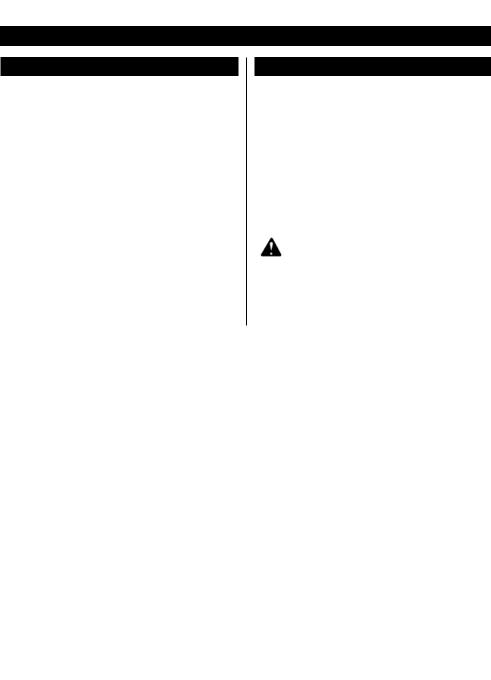
|
|
|
|
|
|
|
|
|
|
|
|
|
|
|
|
|
F |
GB |
D |
E |
|
P |
NL |
S |
DK |
N |
FIN |
GR |
H |
CZ |
RUS |
RO |
PL |
|
|
|
|
|
|
|
|
|
|
|
|
|
|
|
|
|
Italiano
UTILIZZAZIONE (FIG. 3)
I CARTER DI PROTEZIONE DEVONO ESSERE INSTALLATI.
FARE ATTENZIONE A NON COPRIRE LE APERTURE DI AERAZIONE ONDE CONSENTIRE UN ADEGUATO RAFFREDDAMENTO DEL MOTORE.
Per lavorare in modo efficace, è importante controllare la pressione esercitata sull’apparecchio e la superficie di contatto tra la mola ed il pezzo da lavorare. Per molare delle superfici piane, la molatrice deve formare un angolo acuto, in genere tra 10° e 20°, con il pezzo da lavorare. Prima di iniziare la fase di molatura, attendere che la mola raggiunga la velocità massima. Un angolo troppo ampio provoca una concentrazione della pressione su una piccola superficie, nel qual caso, la superficie di lavoro potrebbe bucarsi o bruciarsi.
MANUTENZIONE
Dopo l’uso, verificare sempre lo stato dell’apparecchio.
Si consiglia di portare l’apparecchio almeno una volta all’anno presso un Centro di Assistenza Autorizzato Ryobi per una completa lubrificazione e pulitura.
NON EFFETTUARE ALCUN TIPO DI REGOLAZIONE QUANDO L’APPARECCHIO È IN FUNZIONE. STACCARE SEMPRE IL CAVO D’ALIMENTAZIONE PRIMA DI PROCEDERE AL CAMBIO DEGLI ACCESSORI, DEI PEZZI USURATI (LAMA, PUNTA, CARTA DI VETRO, ECC.) O PRIMA DI LUBRIFICARE O MANEGGIARE L’APPARECCHIO.
ATTENZIONE!
Per maggiore sicurezza ed affidabilità, effettuare tutte le riparazioni presso un Centro di Assistenza Autorizzato Ryobi.
CONSERVARE LE PRESENTI ISTRUZIONI PER POTERLE CONSULTARE ULTERIORMENTE.
15
